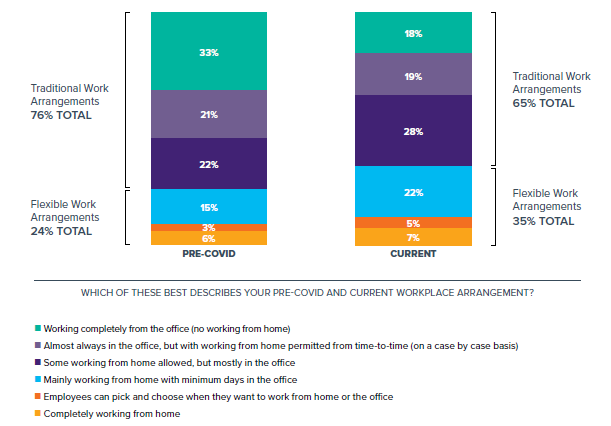
Pitcher Partners recently released Business Radar 2022 report deep dived into the perceived benefits and challenges of ‘flexible work’.
The changing face of work has been much debated since office workers were sent home to their dining tables and bedrooms at the height of the pandemic. Businesses that had resisted flexible working were suddenly forced to have staff working remotely, and many found that it worked well, or at least adequately.
For the purposes of Business Radar flexible work arrangements (FWA) are defined as employees working completely or mainly from home and/or being able to choose when they work at home or in the office. Traditional work arrangements (TWA) are when employees always or mostly work in the office, with working from home either not permitted at all, or only case by case. Flexible work has grown through COVID, but Business Radar findings demonstrated that it still remains the minority.

The benefits of flexibility
Businesses with staff that work flexibly and those with traditional working arrangements both perceive that the models work well for them, indicating that either can work. However, it appears that FWA businesses believe their arrangement is working better; FWA businesses show 10% more confidence and rate the benefits of their model more highly. For example, 48% of FWA businesses say they benefit from greater productivity, compared with 40% for TWA businesses.
That pattern continues with FWA seen as delivering greater staff retention (43% vs 30%), reduced geographic barriers to recruitment (40% vs 15%), cheaper overheads (38% vs 18%), attracting the right staff (33% vs 22%) and a wider employee pool (25% vs 15%).
TWA businesses showed a slight edge over FWA in staff engagement (38% vs 34%) and communication (33% vs 28%), although these differences are not wide enough to be considered statistically significant.
What flexible work arrangements mean in practice
We define flexible work as ‘mainly working from home with minimum days in the office’ or ‘employees picking and choosing their working arrangements’ or ‘completely working from home’. Of these complete flexibility (‘employees can pick and choose…’) is the smallest group before and after COVID (5%, only slightly larger than pre-COVID at 3%).
While the story for flexible work seems positive at first glance, it may hide a more nuanced reality influenced by multiple factors
Perceptions vs reality
These results reflect perceived rather than actual outcomes for the businesses. Although one can expect these to be somewhat aligned, there are factors which may distort the perception vs reality of flexible work productivity.
Post-rationalisation
Businesses with a more flexible arrangement are more likely to have made a change to this model since or during the height of COVID. As a matter of human behaviour, it’s possible that the higher positive sentiment towards FWA reflects (to some extent) their desire to confirm their own strategic decisions.
Businesses able to work flexibly
Work flexibility is not just a matter of discretion of the managers or owners; there are simply some businesses that cannot allow their people to work flexibly. Workplaces that remain strictly at the business’ location tend to be those with bricks and mortar premises, such as retail, hospitality or manufacturing. Flexible businesses tend to be newer, operating online or via e-commerce, consisting of a large volume of processing-type work and providing professional services.
The challenges of flexibility
The experiences of FWA are not positive in all respects and do come with their own challenges. For example, 37% of FWA businesses see integrating new staff as a challenge, compared with only 23% in TWA. Diluting the workplace culture is also more of a challenge for FWA businesses (35% vs 21%) as is reduced collaboration (33% vs 23%) and data security (24% vs 15%).
Workplace culture, team connectedness and collaboration are key components of innovative workplaces
These are not insignificant areas for mid-market businesses. Workplace culture, team connectedness and collaboration are key components of innovative workplaces. Also, despite flexibility being perceived as a remedy for challenges with hiring and retention – onboarding and workplace culture appear to suffer. In some instances this is causing the ‘essence’ of a business to change, meaning the current business is not the same as it was pre-COVID. This could lead to longer term issues requiring pro-active management for businesses to continue to meet their objectives and customer needs.
Perceived benefits: underestimated
Despite the benefits that some decision-makers see in FWA, those working completely from the office are less likely to expect the benefits of flexible work, particularly in the areas of productivity, morale and retention. Over a third of those businesses do not perceive any benefits at all in switching to more flexible arrangements.
Perceived challenges: overestimated
Along similar lines, compared to FWA decisionmakers, those operating completely from the office overestimate the perceived challenges flexible work has on productivity (37% vs 22%) and quality of work (49% vs 17%). Interestingly, they underestimate the challenge of integrating new staff (23% vs 37%).
New research and data continues to be made available and a deep dive into particular industries or business models could provide valuable insights in the future. So watch this space.
Insights for business
Businesses that have leaped into flexible work are seeing more benefit than their TWA counterparts and consider the accompanying challenges as far less. Post-pandemic staff shortages and changing expectations of workers mean offering this flexibility is becoming more urgent, especially when taken alongside our findings around retention and attraction. Key factors seen as creating higher staff turnover were poor work-life balance, poor workplace culture and the offer of better flexibility elsewhere. All of these factors are linked and could, in part, be solved by shifting along the broad continuum from traditional towards flexible working arrangements.
Actions you can take
For those businesses able to move along this continuum, it is important to ensure that this is clearly defined to suit your organisation:
- Will there be set days in the office? A minimum number of days?
- How will monitoring and measuring performance be achieved?
- What requirements will there be on managers to ensure continued connection with direct reports and the team?
- How will culture be managed?
When these questions have been answered, it’s important to develop a clear communication strategy to set exceptions with staff. It is also important that the potential downsides of FWA are monitored and minimised:
- Develop mechanisms to measure productivity and track over time to be alerted to and manage potential declines.
- Build a structured onboarding process to ensure new starters understand the culture and values, create connections across the business and are provided with the right technical and systems training to set them up for success.
- Document and develop programs to showcase your culture and values to your people. Ensure your leadership team role model the behaviours.
- Review your cybersecurity systems and training to ensure the increased risk of remote working arrangements is minimised.
What to do now
Explore further insights through the full Business Radar hub on our website today.











